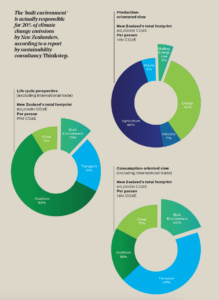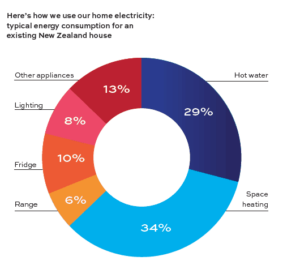Elsewhere in this edition you’ll find disturbing updates on the global warming challenge – 400 consecutive months of above-average temperatures, a threat to 30% of the world’s veggie production, accelerated species extinction. Add in faster melting ice sheets and slower moving cyclones (dumping more and heavier rain) and the future scenario looks pretty grim.

But now for some positive news … something you can do about it.
Starting at home … literally.
Buildings – lighting, heating and cooling them – use 5% of NZ’s energy pie. This is below the global average, due to our use of wood for much of our residential heating and the fact that we don’t actually heat and cool our buildings as much as other developed countries, especially in the residential sector. [See Sarah Cates’ article, p58, for the downside of that!]
Yet the ‘built environment’ is actually responsible for 20% of climate change emissions by New Zealanders, according to a report by sustainability consultancy Thinkstep. Their report takes into account the entire life cycle of a building, from production of the building materials through operational energy used and end-of-life demolition.
The 20% contribution from the built environment to New Zealand’s total gross carbon footprint from a total consumption perspective (after adjusting for international trade) is made up of 8.6% from energy use, 8.7% from building products, 2.1% from imported emissions (primarily services such as insurance) and 0.5% from building and garden waste. The key point here is that material efficiency is as important as energy use efficiency in New Zealand.
Residential energy savings

For the average consumer interested in minimizing their environmental footprint, therefore, selection of building materials and building design can be hugely important, if one is in home-building or renovation mode. But for most of us, our choices revolve around energy efficiency tweaks we can make to our existing abodes.
There’s no question the home energy conservation opportunities are there. Residential use accounts for 32% of NZ electricity consumption (commercial use is another 24%).
Peak electricity demand in the average NZ house is 2.2kW. The technical potential exists to reduce this demand by 0.8kW/house … more than one-third. Such savings would reduce electricity-related emissions by about 34% – about 1,700 ktCO2e/year.
If one is in the home-building or serious renovation mode, better choices abound in building design and construction.
A Design Builders home built in Havelock North in 2009 won NZ’s top award for eco-design – the most efficient home per square metre in NZ at the time. According to Scott Taylor, general manager at Design Builders and president of HB Master Builders, a full-on commitment to energy efficiency in a new build would add about $30,000 to $35,000 in cost. That money goes to features like solar gear, higher-grade insulation (way above minimum code), double glazing, LED lighting, and polished cement floors with in-floor heating, high efficiency wood burners and heat pumps.
“Slapping some solar panels on the roof is not an eco-home,” says Scott, “But combined with good design, efficiency levels can go through the roof.” He says there’s a lot more awareness of what’s in end-products like paint and imported products that carry a transportation footprint.
The energy-consumption savings from these features is relatively straightforward to calculate. For example, an LED is about 85% more efficient than an incandescent light. The best performing windows allow less than half the heat loss of standard double glazing, and less than a quarter the heat loss of standard single glazing. The table above shows the relative efficiencies gained from better insulation and glazing in a typical modeled home in windy, rainy Wellington, illustrating the dominant effect of better insulation.

Insulation is most critical. Says Energywise: “Because insulation is the most important factor influencing energy efficiency and comfort you should always try to use higher levels of insulation than Building Code minimum requirements. It will always be more difficult and expensive to increase the insulation at some later date, so it pays to insulate really well first time around.” Scott reinforces that: “I strongly stress to clients that they upgrade insulation to the highest levels they can afford.”
Estimating the ‘pay-back’ time for a $35,000 energy efficiency investment is more complicated and depends upon energy pricing assumptions and energy cost savings as less electricity is purchased from the grid. Scott estimates 8-10 years or less at present rates.
He notes that an age-60 plus home-builder/buyer is still more likely to spend the extra money on a “bucket list trip”. On the other hand, younger buyers increasing “expect as standard” that a first new house will include the highest points of insulation and solar hot water. They also see these features as key components of enhanced re-sale value. He says that greater attention to health issues are also causing more interest in warm homes, indirectly fueling energy efficiency improvements.
But before those ‘add-ons’, he says, passive design features set the stage – proper north- and east-facing orientation, proper roof pitch (to optimize solar collection efficiency) and overhangs (to shield sun), windows placed for good cross flow, efficient placement of hot water tanks. “And good design shouldn’t cost more money,” he emphasizes.
If you’re not in new-build mode, your energy savings will need to come more incrementally.
The most obvious options for most homeowners include shifting to more energy-efficient appliances, improving insulation, upgrading windows, a more efficient heating source, and solar power. For example, solar water heating can reduce energy costs for hot water by 50-75%.

Says Scott, “I try to get solar into every house I can,” but he acknowledges that it’s still a tough sale. The technology is fast-moving and clients are not sure who to trust. And then there’s the inevitable trade-off between a fantastic counter-top that will make the kitchen a showcase on day 1 versus a panel for the roof that will take years to pay off! But, he insists, “It’s going to take off!”
Solar City is charging into the residential solar market, attacking resistance to costly upfront investment, with its solarZero energy service. SolarCity installs and owns the equipment – solar panels and battery – at its cost and charges the customer for a 20-year service contract. Click Hawke’s Bay on SolarCity’s website and the pop-up claims you’ll save $21,280 over 20 years.
Careful consumers should evaluate such packages mindful of their assumptions about future electricity prices, inflation and interest rates. And also consider the costs to change or exit the arrangement if their circumstances change or they wish to sell their property during its term.
If you’re a renter, there’s still plenty you can do to conserve energy. Here’s an excellent source of ideas, including the latest insulation requirements:
www.energywise.govt.nz/at-home/buying-and-renting/tenants/
The commercial case
Residential users spend $3.2 billion/year on electricity. Commercial and industrial users spend a bit more – $2.1 billion and $1.6 billion, respectively. And $8.4 billion on energy overall – or 50% of NZ’s total energy use accounting for more than 40% of NZ’s energy-related CO2 emission (excluding transportation in each case), according to the Energy Efficiency and Conservation Authority (EECA).
The EECA estimates that many businesses can shave up to 20% off their overall energy costs, claiming they are presently wasting $1.6 billion per year.
Since, like any other business cost, energy expenses directly erode the bottom line, businesses have a clearer ‘line of sight’ to the benefits of day-to-day energy efficiency improvements. But there are ‘softer’ indirect benefits as well in terms of better, healthier and safer working conditions, along with improved staff morale and brand goodwill – all contributing to measurable productivity benefits as well.

And here are the savings opportunities in a typical office setting – pretty basic stuff like turning off electronic equipment, using efficient lighting, having proper insulation.
For most businesses – and probably for average consumers as well – curbing carbon emissions and global warming isn’t their first priority each morning.
But if present emission trends continue, it won’t be but a decade or two before each home and workplace will become a ‘ground zero’ in what will have become an urgent daily battle to curb catastrophic climate change.
Sources:
www.energywise.govt.nz
(see especially, Designing Comfortable Homes: Guidelines on the Use of Glass, Mass and Insulation for Energy Efficiency)
www.eeca.govt.nz
(see especially, Concept Consulting Group: What is the case for electricity efficiency initiatives?)
www.eecabusiness.govt.nz/start-saving-energy/your-industrial-site/
www.eecabusiness.govt.nz/start-saving-energy/your-office/


